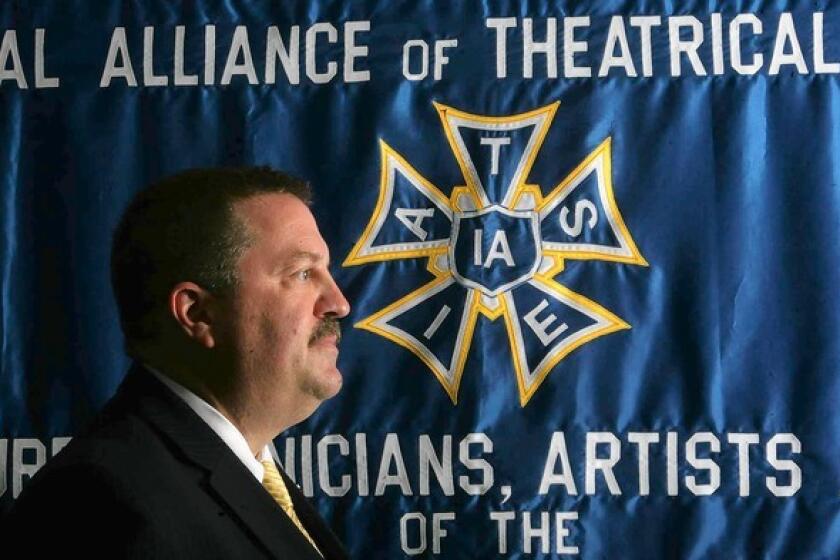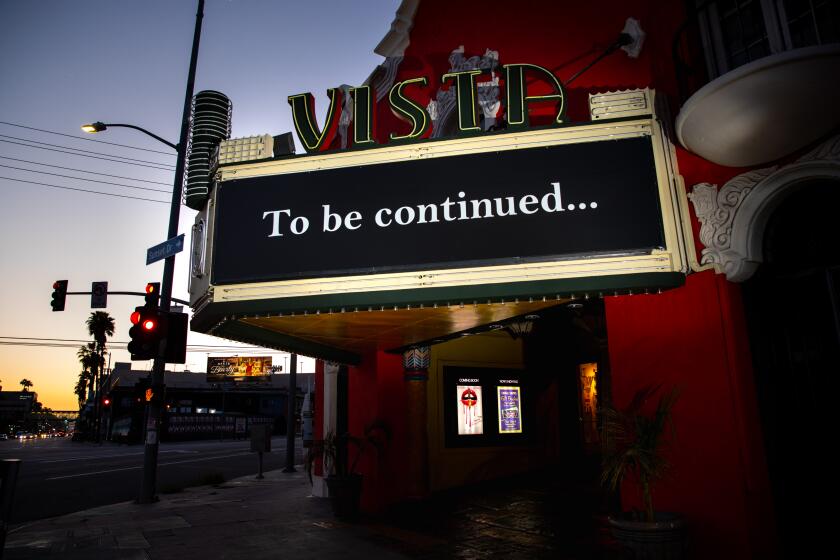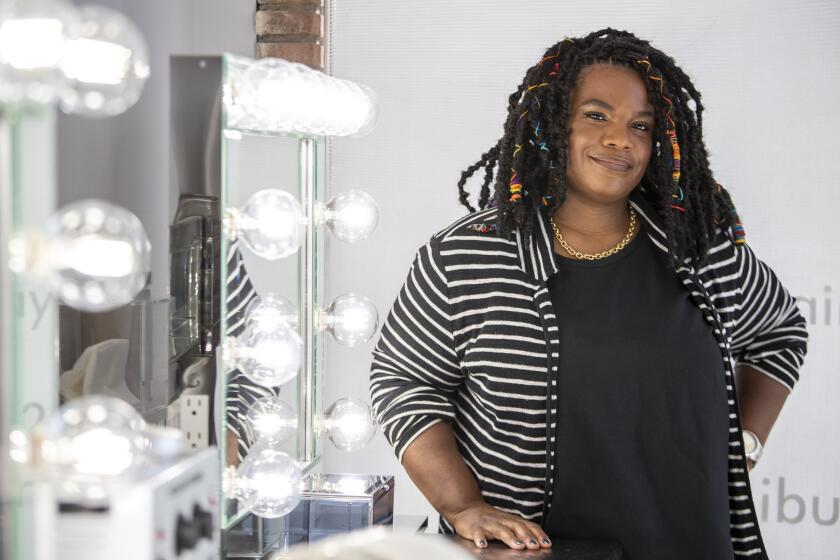Ava DuVernay and Peter Roth have a plan to diversify crews. And Hollywood is on board
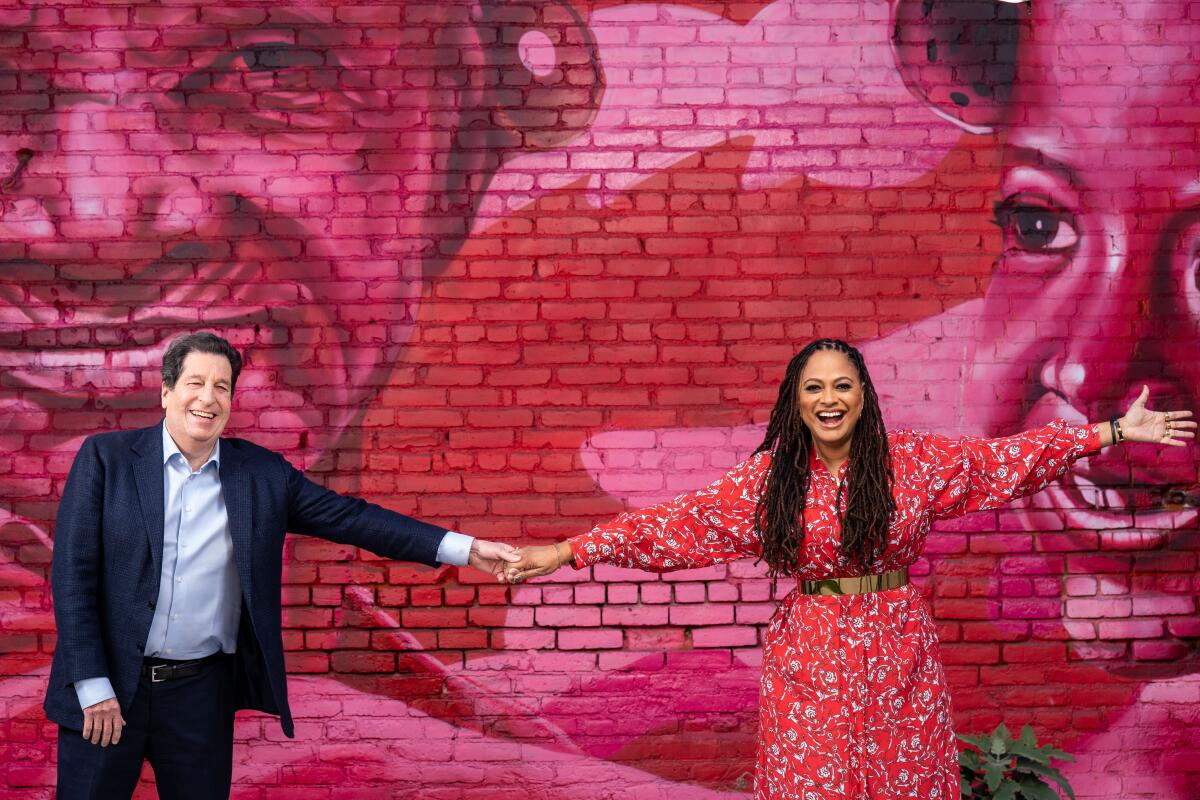
- Share via
To hear Peter Roth tell it, friends, including J.J. Abrams, had been insisting he needed to know Ava DuVernay long before their first meeting.
So when the longtime Warner Bros. TV executive found himself across from the filmmaker at the Los Angeles offices of Oprah Winfrey’s cable network, OWN, to discuss collaborating on DuVernay’s Louisiana-set television drama “Queen Sugar,” the creative connection, as they say, was instant.
“I’ve never had the experience of being so closely connected with someone who’s probably, just on paper, the polar opposite of me — not a woman, not Black, not my age and certainly not anyone with as much power as Peter has,” says DuVernay. “It serves as a model for the kinds of relationship[s] that we can be in, in our industry.”
That bond led DuVernay to sign a massive multiyear deal with Warner Bros. TV in 2018 and, now, has inspired the pair to join forces to bring what they hope is lasting change on Hollywood sets.
Through Array Alliance, the nonprofit arm of her company Array, DuVernay and her team have assembled a database of below-the-line talent designed to bridge the hiring gap for women and people of color in the entertainment industry. And with Roth’s help securing studio competitors such as Sony, Netflix and Disney, to sign onto and invest in the project, Array Crew is positioned to be a resource for executives and hiring managers throughout Hollywood amid the ongoing push for more inclusive crews.
Already in a soft launch stage, the searchable database so far features 2,500 profiles, which can be sorted by crew position, experience, location and more — think IMDb meets LinkedIn. The database is free to qualifying talent, who must have at least one verified credit. While the purpose of the database is to make it easier to find qualified women and people of color for crew positions, it’s open to everyone. It’s focused on U.S.-based talent, but there are plans to expand it to include the U.K. and Canada next year.
It marks one of Roth’s last initiatives as chairman of Warner Bros. Television Group. At the start of the new year, he’ll step down from his role after a 22-year run in which he shepherded such TV hits as “The West Wing,” “The Big Bang Theory,” “Two and a Half Men,” and “Gilmore Girls.”
In a joint interview over video call, DuVernay and Roth spoke about the wrinkles in Hollywood’s hiring practices, getting studios to band together for the database and not letting the COVID-19 pandemic stymie inclusion efforts. These are edited excerpts from the conversation.
The union representing film and television crew members announced initiatives to improve diversity in its ranks.
Ava, you’ve always made it a priority to be inclusive with your projects. When did it hit you that you had to set up a system for crew inclusion to see real change?
DuVernay: The genesis of it was a lot smaller than it is now. And Peter has a lot to do with that. We thought: “Oh, let’s just put together names of a bunch of people that we know — like everyone else in town, make a list.” There’s all these lists that people have ... literally, like little pieces of paper. You ask, “Can I see the list?” Everyone has one. CAA has one. But they weren’t together in one [omnibus list]. So, the first thing we thought about is: “Let’s go to everyone and say, ‘Hey, why don’t we all put our lists into one kind of spreadsheet, so we have one mega-list. People weren’t with that. And it’s like, “You’re proprietary with those 30 names? Are you serious, that little list, you don’t want to give?” Fine, we’ll make our own. The first two weeks, we had 500 people on a spreadsheet. After a while it was 750 and then 1,000 and then people calling and hearing about it, and it became a bit of a thing.
It was really Peter who said: “We should contact everyone.” He helped me think larger in terms of studios taking part in the foundation of it in a way that made it feel like theirs, which was our original idea. He knew, from a business perspective, [the studios] should invest in this so that you feel like it’s yours. And that’s why we are where we are now where it’s not a spreadsheet ... It is a tech company with a chief, with a CTO and a full staff and a fully vetted backend that is proprietary that we built from scratch.
Roth: You must tell the “A Wrinkle in Time” story. Because that is a beautiful story. And it’s so illustrative of why this is such an important, powerful and game-changing initiative.
DuVernay: I think as a Black woman who’s been fighting in this industry to not knock on doors but to create my own door, my default — and the reason why this relationship has been very instructive for me and illuminating — unfortunately, is: “They’re trying to keep me out. This is happening against me. And I’m gonna fight you back.” That’s unfortunately how we as women of color kind of walk through. We walk in the room, and it’s not the ease of, “Oh, I’m going to be accepted on my merits. And they’re going to get to know me, and we’re going to start from there.” No, I have to walk in feeling on the defense because I’m chipping away at whatever the preconceived notions are.
So, I was on “A Wrinkle in Time,” and I had all of my department heads, and I said when we started: “I’m hiring you because I think you’re great. And I’m making you responsible for your department, and [you’re] assuring me that it will be [an] inclusively staffed crew. I’m not saying you have to hire the woman or the person of color, but you’ve got to interview a woman or person of color; you can’t just bring all your friends, all your white men friends from the other show. You’ve got to show me that for every single position on your crew on your department, that you have looked at someone else that you haven’t looked at before.” We’re getting close to the production. I’m reviewing a crew list, and I look at the camera department. And I’m thinking, what’s going on? All white guys. So I call in Tobias Schliessler [director of photography]. I’ve got my armor on, and I say, “What is going on here? When we decided to work together, you told me that this was important to you. I believed you.” And he looked at me, and he was shook. He was hurt. I could see his hurt in his eyes. I get emotional thinking about it. He said to me, “I know how important this is. And I just want to do my best for you. And I know these people will give you the best I could give. I don’t know those other people, and there’s too much riding on this. I don’t know them. But I know these guys, and I know that they will get it done. I’m trying to do my best for you. That’s what this is. I’m interviewing other people, but I’m not sure.”
I saw for the first time [that] maybe it’s not all, “I’m trying to keep you out.” It’s just, you don’t know how. You don’t know where to look. You don’t know who to ask. ... Maybe the fight is to help them; help them understand how to do it. And that’s something to wrestle with because do I want to take time out of my creative space to aid in the forward movement of other people and in the psychological progress of other people as it pertains to race and gender? Not really. But if someone doesn’t stop and do it, how does it get done?
From director’s chairs to executive suites to movie theater seats, no element of Hollywood will be untouched as society movies forward from the pandemic. We asked people all around the industry what the future might look like.
How many studios have access to this?
DuVernay: Every studio. And you know why? This man.
Peter, talk to me about making those calls, making those connections.
DuVernay: Tell the true story, Peter, tell how hard it was.
Roth: Well, it wasn’t hard with everybody. But it required a couple of phone calls, I have to say.
DuVernay: ”The Godfather” came out a couple of times.
Roth: When something is so obvious and so right — I mean, that “Wrinkle in Time” story probably moved every single studio representative. Every one. It’s such a powerful story. You know, I can’t tell you how many times in my career, whether it was an actor, a director — forget about below-the-line crews — but how many times I’ve heard the words: “Well, we looked everywhere. We exhausted all possibilities.” And this is a living document, an example, of why we didn’t and we haven’t. What Ava has done, and her team has done, is she’s created access for us of information of people that are so worthy and so capable. And we always hid behind: “Well, we really tried, we really looked everywhere” ... but we didn’t. That’s why [the database] is so important. It’s one thing to say we really want to change. It’s another thing to have the information, the access, the data to be able to change.
So with that in mind, I called the heads of all the studios. Alan Horn [now Walt Disney Studios chief creative officer] happens to be an old dear friend, as he is with Ava, by the way; Jim Gianopulos [chief executive of Paramount Pictures]; Tony Vinciquerra [chairman of Sony Pictures Entertainment] — I just called everybody. And we started by having Ava and her team put forth these extraordinary demonstrations. We would have about 150 people per presentation. And the comments were, “Oh my God, this is a game changer. Nothing will ever be the same.” Because when you see it, you realize it is such a brilliantly simple idea, such an important idea. How can you say no?
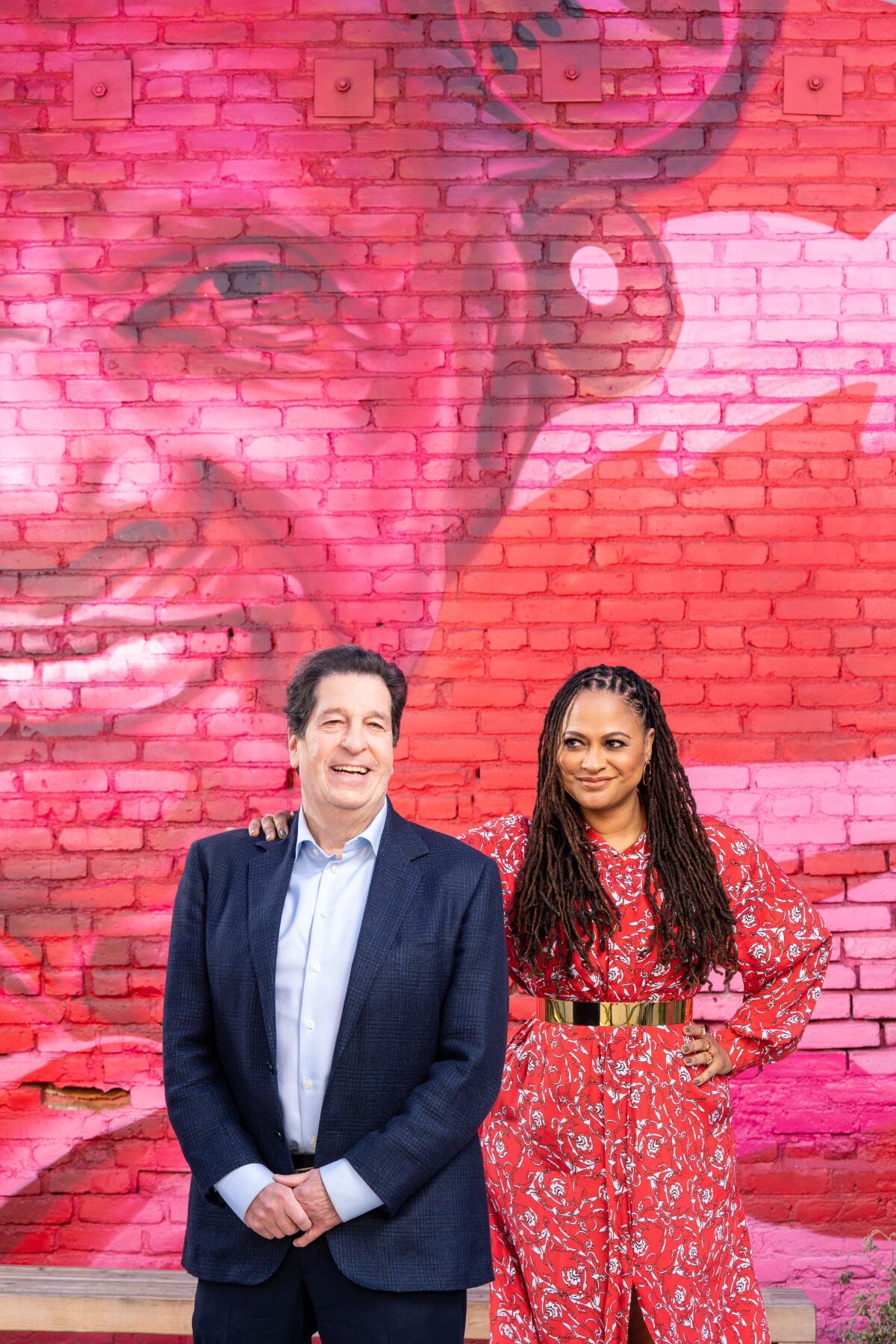
What were the concerns that required assuaging?
Roth: It was an investment. It’s a significant amount of money that every studio needed to put up. Relative to the need, and relative to the import, it’s nothing. It’ll be the best investment we ever make — all of us. And I think we’re going to look back years from now and think: “I can’t believe anybody hesitated.” I think that it was really about the expenditure of cash, “Can I trust my competitor in supporting this?” But this transcends all of us. It transcends competition. It’s what’s important for our industry. Maybe three or four calls in some cases but nothing that eventually I couldn’t wear them down.
Hollywood production is in this weird period because of the pandemic — some things have started back up, others have not, or some have started and stopped. And there’s this concern that this period will have a negative effect on inclusion efforts. What is your view?
DuVernay: There’s an opportunity here to slide back or to catapult forward. We know that nothing will be the same, right? This is the time. We’re in the gap. And so our goal is to provide this tool so, “No, no, no, don’t, no, you’re not going back, we’re not gonna let you ... keep moving; keep moving forward.” And because there is that danger, we have to be aggressive and assertive in making sure that that’s not so. And it’s not the end-all, be-all. Look, if in five years there’s no Array Crew and there’s 10 other ways that you can get people and sourced across all industries that someone else has done, great. This is all coming out of our nonprofit. But, you know, as we’ve started working with these studios, their needs, I mean, Netflix alone — my God, it’s worldwide. I talked to them, and they’re like, “Um, do you have crew in India?” No, not yet. Can we just start in L.A. and New York? Warner Bros., whenever I get on the phone with them or any studio, [they say]: “We need the U.K. on board right now. Can you get the U.K. done?”
One of the things that I say on those those calls, those demonstrations, is this is not Yelp. We’re not rating people. We’re not doing recommendations. We’re helping you find people so you can do your job and vet them according to your needs. That was a tough question: “Well, how do we know these people are good people?” You don’t. Interview them like you interview everyone else. At that base level, in this precarious time, if we can at least provide that access to people, the hope is that the good will kick in. And folks will use it.
Hollywood’s unions are gatekeepers to the entertainment industry, yet Black crew members say getting access for recognition for minority members is hard.
It’s been a couple of years since Frances McDormand, with her Oscars speech, had folks talking about “inclusion riders.” And there have been vows by others to use them, but whether they’re actually implemented on productions is somewhat unclear. I’m curious, Ava, about your view on mandates or quotas?
DuVernay: I think that there are ways in which forward-thinking people in our industry can shape our culture. And do those need to be government mandates? I don’t think so. But do there need to be some rules, policies, some advantage to folks to do it? Yeah. Because if it can be done without it, it would have been done. And so the idea that the academy is saying, “Look, you want the best picture thing, and this is important to you, you got to do a few things.” Have to at least seem to make an effort. To allow the industry to do it on its own — we’ve seen what that has gotten us. Diversity divisions, diversity programs.
That’s why when I went to Warner Bros. and said: “No, I want these directors to direct an episode of ‘Queen Sugar.’ Not shadow, not do the class in the program. Not putting those things down. I just think that they stopped at a certain point. And it was because they were a Band-Aid on something that’s a disease. So we need to get to the systemic issues here. And the systemic issues have to do with the way that we work. The way that we work is very colloquial, it’s very local. We work with the same people over and over, and you can’t get inclusive unless your circle widens. And so we need to create tools, opportunities and model what it’s like when you go outside of your circle. Peter and I are not in the same circle. Right? We have different circles. And yet, by spending time together and talking about the things that matter to us, we found a common ground. More than a common ground — it wasn’t a negotiation. A real connection. And from that connection, we were able to do work. I just wish that happened more. You know, I talked to J.J. [Abrams] about this. It’s like, “I don’t hang in the same place as you do.” But even with him, we’ve been able to find and create a friendship out of the things that we do have in common. It was only because we put ourselves together to do that. I just wish people did that a little bit more. If we got out of our silos, there’s so much work to do.
Roth: It is not simply a cliche, it is the absolute truth, that inclusion is good business. To be inclusive, is to reflect this country. I mean, how many reports do we have to read to know that the white population will be decreasing, and there will be a greater diversity — natural, organic diversity — in this country than ever before? Reflecting the perspectives and the stories and the emotions, which we all have, of a group of people that are not as well represented? How can you not do that? Look at “Black Panther,” look at the work that Ava is doing — “When They See Us.” I think about the work of Jordan Peele. What these fabulous filmmakers are doing is they’re offering different perspectives on a familiar theme. And that can be the definition of good business. Updated variations on familiar things is an idea that we’ve been espousing at Warner Bros. for years and how we develop. To look at the perspective of life from a different point of view is just smart. It’s not only the right thing to do, it’s a good thing to do.
What will be your measure of success?
DuVernay: That people use it. That we see people getting hired from it. I have no designs for it to be, you know, a behemoth. And we can track that. We can see how people are on, what studios are using it, how they’re using it, who they’re hiring.
Roth: For me, as I enter this next chapter, what I hope to do is to be able to look back a year, two years, five years from now and see that this brilliant initiative will become the norm that we won’t have to track statistics because it just is that you’ll look at a crew and you’ll see a wide array, forgive the pun, of faces, of perspectives, of people that represent much more effectively the country that we live in and the world that we live in. I can’t think of anything more meaningful as I say farewell to Warner Bros. than to have been a part of this.
More to Read
The complete guide to home viewing
Get Screen Gab for everything about the TV shows and streaming movies everyone’s talking about.
You may occasionally receive promotional content from the Los Angeles Times.
